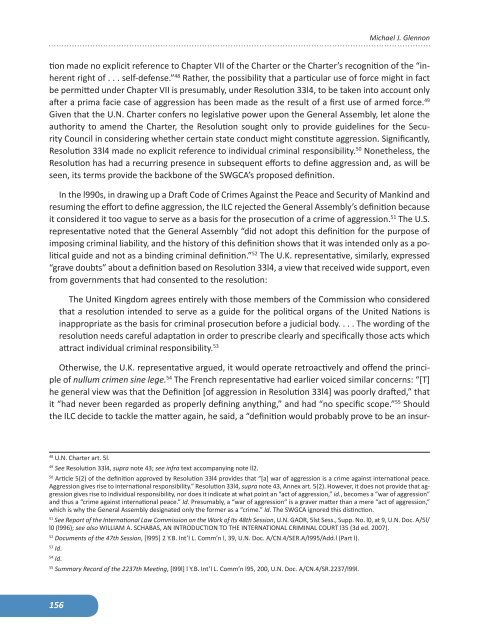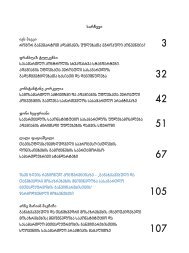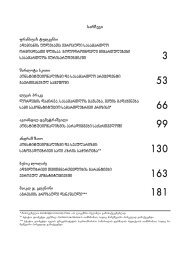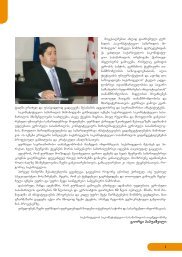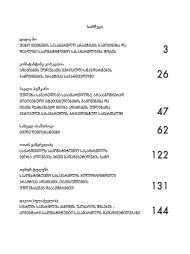Contents - Constitutional Court of Georgia
Contents - Constitutional Court of Georgia
Contents - Constitutional Court of Georgia
You also want an ePaper? Increase the reach of your titles
YUMPU automatically turns print PDFs into web optimized ePapers that Google loves.
156<br />
Michael J. Glennon<br />
tion made no explicit reference to Chapter VII <strong>of</strong> the Charter or the Charter’s recognition <strong>of</strong> the “inherent<br />
right <strong>of</strong> . . . self-defense.” 48 Rather, the possibility that a particular use <strong>of</strong> force might in fact<br />
be permitted under Chapter VII is presumably, under Resolution 33l4, to be taken into account only<br />
after a prima facie case <strong>of</strong> aggression has been made as the result <strong>of</strong> a first use <strong>of</strong> armed force. 49<br />
Given that the U.N. Charter confers no legislative power upon the General Assembly, let alone the<br />
authority to amend the Charter, the Resolution sought only to provide guidelines for the Security<br />
Council in considering whether certain state conduct might constitute aggression. Significantly,<br />
Resolution 33l4 made no explicit reference to individual criminal responsibility. 50 Nonetheless, the<br />
Resolution has had a recurring presence in subsequent efforts to define aggression and, as will be<br />
seen, its terms provide the backbone <strong>of</strong> the SWGCA’s proposed definition.<br />
In the l990s, in drawing up a Draft Code <strong>of</strong> Crimes Against the Peace and Security <strong>of</strong> Mankind and<br />
resuming the effort to define aggression, the ILC rejected the General Assembly’s definition because<br />
it considered it too vague to serve as a basis for the prosecution <strong>of</strong> a crime <strong>of</strong> aggression. 51 The U.S.<br />
representative noted that the General Assembly “did not adopt this definition for the purpose <strong>of</strong><br />
imposing criminal liability, and the history <strong>of</strong> this definition shows that it was intended only as a political<br />
guide and not as a binding criminal definition.” 52 The U.K. representative, similarly, expressed<br />
“grave doubts” about a definition based on Resolution 33l4, a view that received wide support, even<br />
from governments that had consented to the resolution:<br />
The United Kingdom agrees entirely with those members <strong>of</strong> the Commission who considered<br />
that a resolution intended to serve as a guide for the political organs <strong>of</strong> the United Nations is<br />
inappropriate as the basis for criminal prosecution before a judicial body. . . . The wording <strong>of</strong> the<br />
resolution needs careful adaptation in order to prescribe clearly and specifically those acts which<br />
attract individual criminal responsibility. 53<br />
Otherwise, the U.K. representative argued, it would operate retroactively and <strong>of</strong>fend the principle<br />
<strong>of</strong> nullum crimen sine lege. 54 The French representative had earlier voiced similar concerns: “[T]<br />
he general view was that the Definition [<strong>of</strong> aggression in Resolution 33l4] was poorly drafted,” that<br />
it “had never been regarded as properly defining anything,” and had “no specific scope.” 55 Should<br />
the ILC decide to tackle the matter again, he said, a “definition would probably prove to be an insur-<br />
48 U.N. Charter art. 5l.<br />
49 See Resolution 33l4, supra note 43; see infra text accompanying note ll2.<br />
50 Article 5(2) <strong>of</strong> the definition approved by Resolution 33l4 provides that “[a] war <strong>of</strong> aggression is a crime against international peace.<br />
Aggression gives rise to international responsibility.” Resolution 33l4, supra note 43, Annex art. 5(2). However, it does not provide that aggression<br />
gives rise to individual responsibility, nor does it indicate at what point an “act <strong>of</strong> aggression,” id., becomes a “war <strong>of</strong> aggression”<br />
and thus a “crime against international peace.” Id. Presumably, a “war <strong>of</strong> aggression” is a graver matter than a mere “act <strong>of</strong> aggression,”<br />
which is why the General Assembly designated only the former as a “crime.” Id. The SWGCA ignored this distinction.<br />
51 See Report <strong>of</strong> the International Law Commission on the Work <strong>of</strong> Its 48th Session, U.N. GAOR, 5lst Sess., Supp. No. l0, at 9, U.N. Doc. A/5l/<br />
l0 (l996); see also WILLIAM A. SCHABAS, AN INTRODUCTION TO THE INTERNATIONAL CRIMINAL COURT l35 (3d ed. 2007).<br />
52 Documents <strong>of</strong> the 47th Session, [l995] 2 Y.B. Int’l L. Comm’n l, 39, U.N. Doc. A/CN.4/SER.A/l995/Add.l (Part l).<br />
53 Id.<br />
54 Id.<br />
55 Summary Record <strong>of</strong> the 2237th Meeting, [l99l] l Y.B. Int’l L. Comm’n l95, 200, U.N. Doc. A/CN.4/SR.2237/l99l.


